Notes: Radcliffe station was situated on the Lancashire & Yorkshire Railway (LYR) Manchester, Whitefield Radcliffe and Bradley Fold line. The line was authorised though two acts, Manchester (Cheetham Hill) to Radcliffe on 18 July 1872 and Radcliffe to Bradley Fold Junction on 28 June 1877). The purpose of the line was to create an alternative route between Bury and Manchester that served the settlements of Whitefield and Prestwich. The LYR had a route between Bury and Manchester which passed through Radcliffe that had opened on 25 September 1846. This route had been opened by the East Lancashire Railway (taken over by the LYR on 13 May 1859) and reached Manchester via Clifton. The Whitefield line connected to the 1846 route to the north-east of the town centre at Radcliffe North Junction (click here to read about Radcliffe North Junction signal box).This link diverged from the main line ½ mile to the south of Radcliffe North Junction at what became Radcliffe South Junction and it was called the Radcliffe East Fork.The section of line between Radcliffe South Junction and Bradley Fold Junction connected to the Bolton and Bury route of the LYR which had opened on 20 November 1848 (thereby providing a direct route to Bolton).
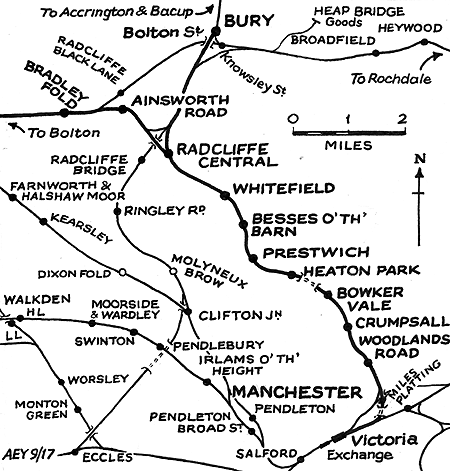 On 30 July 1879 the section of line between Cheetham Hill Junction and Whitefield was passed by the Board of Trade. Goods services began on 1 August 1879. Passenger services only began after the section between Whitefield and Radcliffe North Junction had received Board of Trade approval on 1 September 1879. From this date passenger services began to run between Manchester Victoria and Bury. On 30 July 1879 the section of line between Cheetham Hill Junction and Whitefield was passed by the Board of Trade. Goods services began on 1 August 1879. Passenger services only began after the section between Whitefield and Radcliffe North Junction had received Board of Trade approval on 1 September 1879. From this date passenger services began to run between Manchester Victoria and Bury.
The line to Bradley Fold Junction opened to all traffic on 1 December 1879.
A further line also opened on 1 December 1879. It diverged from the 1846 Clifton route at Radcliffe North Junction and curved westwards to join with the Bradley Fold route at Radcliffe West Junction (click here to read more about the signal boxes of Radcliffe West Junction). It was called the Bradley Fold West Fork. The 1879 lines created a large triangle at Radcliffe with the 1846 route passing through the middle (it passed under the Radcliffe South Junction – Radcliffe West Junction line to the north of Pring Lane).
Radcliffe station opened on 1 December 1879. The original Radcliffe station on the 1846 line, which had been called Radcliffe, was renamed Radcliffe Bridge. The 1879 station was often referred to as Radcliffe ‘New’ station even on some maps.
It was located just to the north of Radcliffe South Junction. The main facilities were in the fork of the junction on the south side of Pring Lane. The line was on an embankment and a wide driveway linked the station entrance to the lane.
Passengers passed through an entrance that was below track level. It led to a spacious booking hall that was provided with natural light through the provision of sky light windows.
Being in the fork of the junction the building gave direct access to the up (Manchester direction) platform of the Bradley Fold line and the down platform of the Radcliffe East Fork line (Bury direction). Subways connected to the up platform (Manchester direction) of the East Fork line and to the down platform of the Bradley Fold line (Bolton direction). The down Bradley Fold line platform was number 1 and the up was number 2. The down East Fork line (for Bury) was 3 and the up East Fork line (for Manchester) was 4.
All of the platforms were provided with canopies. Platforms 1 and 4 also had waiting facilities.
The south junction was controlled by a signal box which opened in 1879. It was located to the south of the junction on the down side of the line. At the time of opening the box and the junction were called Radcliffe Station Junction (click here to read more).
Radcliffe ‘New’ was provided with extensive goods facilities. They were located on the north side of Pring Lane between the Radcliffe East Fork and the Bury - Manchester via Clifton route. A large goods yard with 13 sidings extended all the way up to Radcliffe North Junction. At the south end of the yard there was a large goods shed and facing onto Pring Lane there were goods offices. An older goods shed that had served the Clifton line was incorporated into the new facility. It was located on the western side of the side next to the Clifton line.
The December 1895 timetable showed over 30 trains in each direction Monday-to-Friday with extra and retimed workings on Saturdays. On Sundays there were 7 trains in each direction.The trains were fairly evenly split between the Bolton – Manchester and the Bury – Manchester routes. Many trains running along the East Fork ran to and from destinations north of Bury such as Ramsbottom and Bacup.
In 1898 Radcliffe South Junction signal box was closed and replaced. The new box was located on the southern end of platforms 2 and 3. The box was an all wood LYR Size 5 structure fitted with a 32 lever LYR frame (click here to read more).
The 1904 Handbook of Stations listed Radcliffe as having facilities for handling passengers and parcels, furniture vans, livestock, horses and private carriages by rail. The goods yard was equipped with a 10-ton lifting crane.
The introduction of electric trams to destinations along the Whitefield line in the early 1900s had a big impact on passenger receipts. By 1903 there were between 40 and 45% fewer passenger journeys on the line from the stations south of Prestwich when compared to the 1890s. The LYR had faced this problem before in the Liverpool area and the solution there, which had proved to be successful, was electrification. The LYR decided to electrify the route between Manchester Victoria and Bury Bolton Street in December 1913 using the 1200v dc side contact live rail system. Work began after 21 May 1914. The first electric trains started to run on 17 February 1916 but a full electric service was not possible until August 1916. This was because the LYR Horwich works which built the trains was engaged in work for the war department.
At Radcliffe station it was the East Fork lines that became part of the electrified route between Manchester Victoria and Bury Bolton Street. The platforms on the Bradley Fold line were also energised along with a turn back siding.
The introduction of the full electric service altered the pattern of train services at Radcliffe ‘New’ station. An intensive service was operated between Bury and Manchester leaving little capacity on the line. For that reason through services between Bolton Trinity Street and Manchester Victoria ceased to run. Instead the Bolton services terminated at or started from Radcliffe, the electric service providing good connections. A rail motor was introduced onto the Bolton service which ran mostly at an hourly interval throughout the day. Services to and from Bacup were diverted away from Radcliffe ‘New’ (running via Bury Knowsley Street and Castleton South Junction instead).
On 1 January 1922 the LYR was taken over by the London & North Western Railway (LNWR).
The LNWR was merged with other companies on 1 January 1923 to form the London Midland & Scottish Railway (LMS). The LMS timetable for 1932 showed a 20 minute frequency in each direction for most of the day Monday-to-Friday on the Bury – Manchester electric service. There were 10 trains to and 9 from Bolton Trinity Street. Additional trains ran on both lines on Saturdays. A half hourly electric service in each direction ran on Sundays but there were only 4 trains to and 2 trains from Bolton Trinity Street.
On 11 September 1933 the station was renamed as Radcliffe Central. By this time platform 1 had lost its canopy. There was probably little need for it as arriving and departing Bolton trains were mainly using platform 2.
Radcliffe Central became part of British Railways [London Midland Region] (BR[LMR]) on 1 January 1948.
The 8 June 1953 timetable showed a 10 minute frequency on the Manchester – Bury service at peak times Monday-to-Friday. Outside of the peak and on Saturdays the service was mostly half hourly. There were 6 trains to and 5 from Bolton Trinity Street. There was a good level of service between Manchester and Bury on Sundays but no trains to or from Bolton Trinity Street.
On 21 September 1953 BR[LMR] withdrew the Bolton service. This left platforms 1 and 2 without regular passenger trains although excursions and holiday trains ran from them.
On 7 July 1958 BR[LMR] closed Radcliffe Bridge station.
In 1958 work began on a £110,000 rebuild of Radcliffe Central. The new facilities were completed by 5 June 1959 when they were visited by Sir Brian Robinson the Chairman of the British Transport Commission. Compared to the 1879 station the new facilities were bright and airy and there was much use of glass and steel.
The new station was provided with only three platforms, platform 1 being dispensed with.The Bradley Fold line had long since ceased to be the main line so the platforms were renumbered. The up Radcliffe East Fork platform became number 1, the down Radcliffe East Fork became 2 and the up Bradley Fold platform became 3.
New electric trains were introduced onto the line in 1959 and the future seemed bright but the Reshaping of British Railways Report of 1963 (The Beeching Report) heralded a massive retrenchment for the railways of Radcliffe. The Manchester, Whitefield and Radcliffe line was listed for closure (as was the route to Manchester via Clifton and the Bolton line). There was a great deal of opposition to the proposed closures and in 1966 the line between Manchester and Bury via Whitefield was reprieved.
Closure of the line between Radcliffe South Junction and Bradley Fold Junction went ahead on 2 November 1964. The Radcliffe West Fork closed at the same time.
The Radcliffe Central goods yard closed on 23 May 1966 and the 1846 line between Radcliffe North Junction and Clifton Junction closed completely on 5 December 1966.
The Bury Bolton Street and Manchester Victoria service continued to run. Apart from a few extra workings during the peak trains ran at a frequency of 30 minutes in each direction for most of the day. In 1971 the station was renamed as simply Radcliffe.
In the 1980s plans were drawn up for the creation of a metro style tram system for Greater Manchester. The Manchester Victoria and Bury line was selected to be part of the network. On 13 July 1991 the section of line between Manchester Victoria and Crumpsall closed completely so that it could be converted for tram use. Passenger trains continued to run between Bury and Crumpsall until 17 August 1991 when the rest of the line was closed. On this date Radcliffe station closed permanently as a railway station.
The Metrolink tramway opened through Radcliffe on 6 April 1992 and the station became one of the tram stops.
Tickets from Michael Stewart and route map by Alan Young
Sources:
- A Regional History of the Railways of Great Britain - Volume 10 The North West - Geoffrey O Holt, David & Charles 1986.
- Forgotten Railways - North West England - John Marshall, David & Charles 1981.
- The Lancashire & Rorkshire Railway, Volume 1 - John Marshall, David & Charles 1969.
- The Lancashire & Yorkshire Railway Volume 2 - John Marshall, David & Charles 1970.
See also: Radcliffe Bridge
Click here to see the other stations between Radcliffe and Bolton:
Ainsworth Road, Bradley Fold and Darcy Lever
See also: Bury Bolton Street |

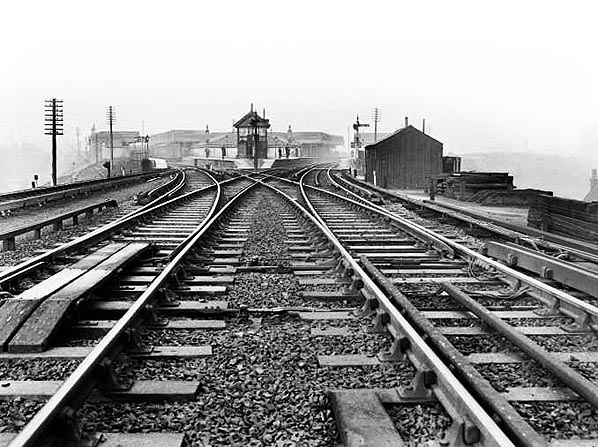
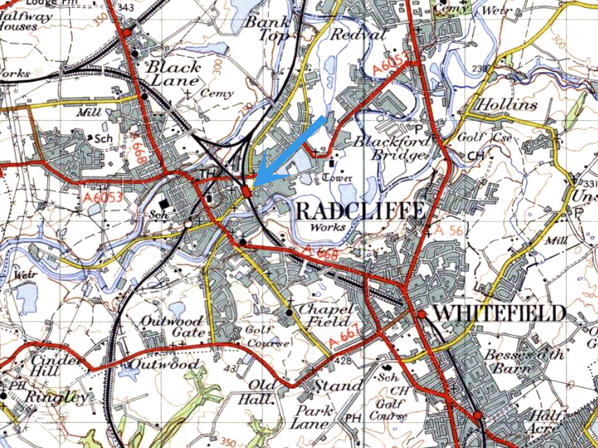
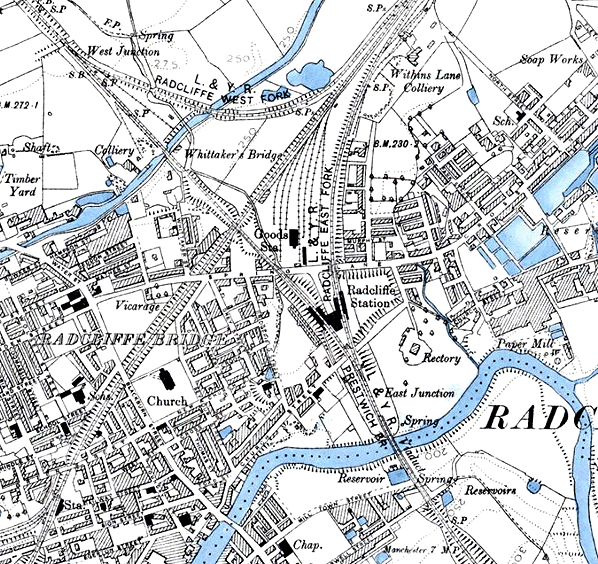
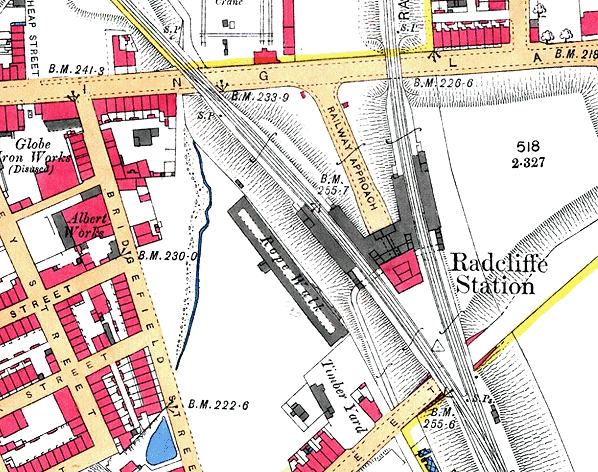
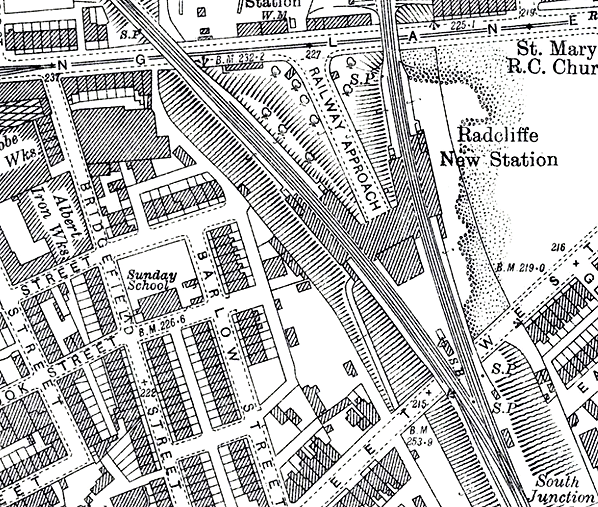
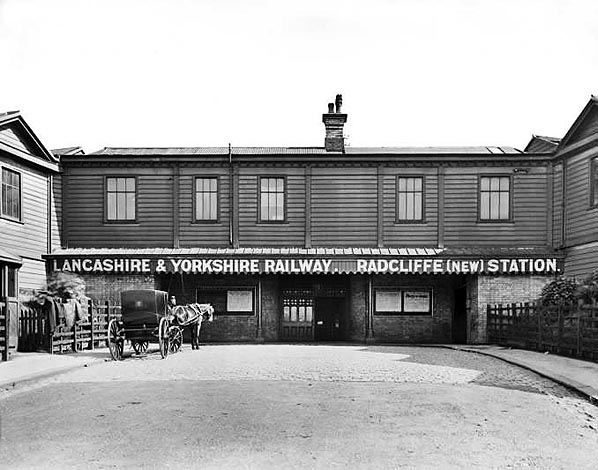 The main entrance to Radcliffe station looking south from the approach road in 1916. The word 'New' is displayed in the title to differentiate the station from the earlier facility that had been renamed as Radcliffe Bridge. The term 'new' persisted until 1933 by which time the station was over 50 years old.
The main entrance to Radcliffe station looking south from the approach road in 1916. The word 'New' is displayed in the title to differentiate the station from the earlier facility that had been renamed as Radcliffe Bridge. The term 'new' persisted until 1933 by which time the station was over 50 years old.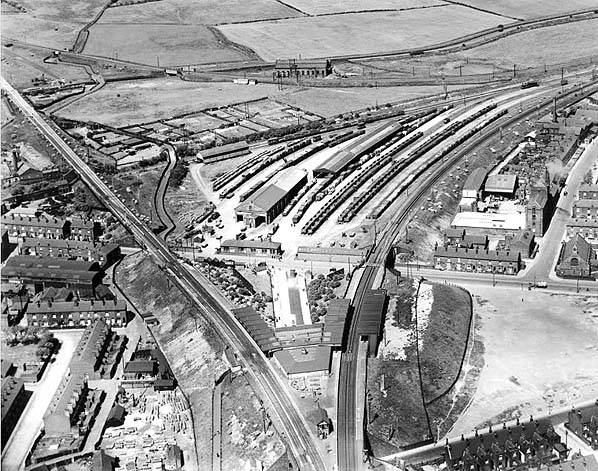
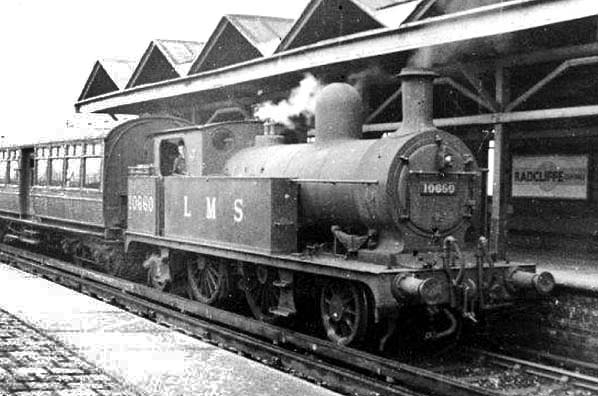 A Bolton Trinity Street service is seen at Radcliffe Central platform 2 in the 1930s. Since 1916 services from the Bolton line had termined at Radcliffe Central.
A Bolton Trinity Street service is seen at Radcliffe Central platform 2 in the 1930s. Since 1916 services from the Bolton line had termined at Radcliffe Central.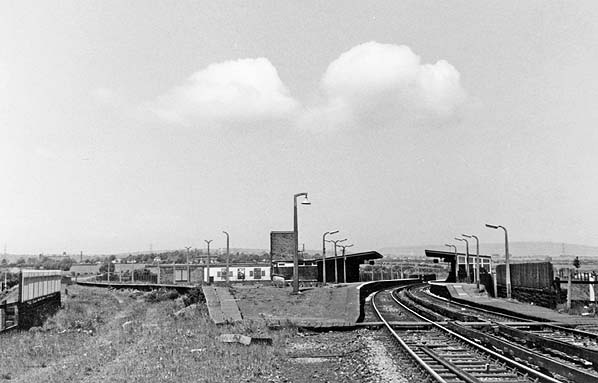
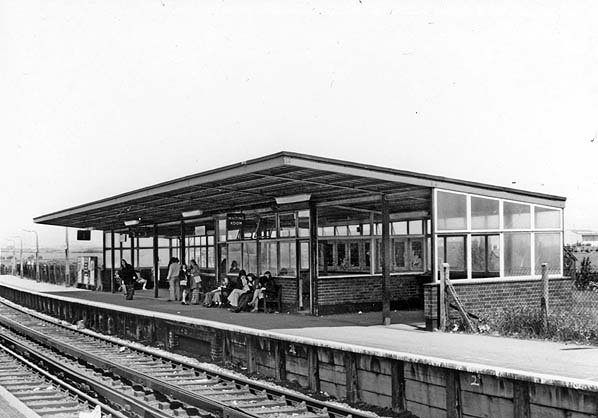
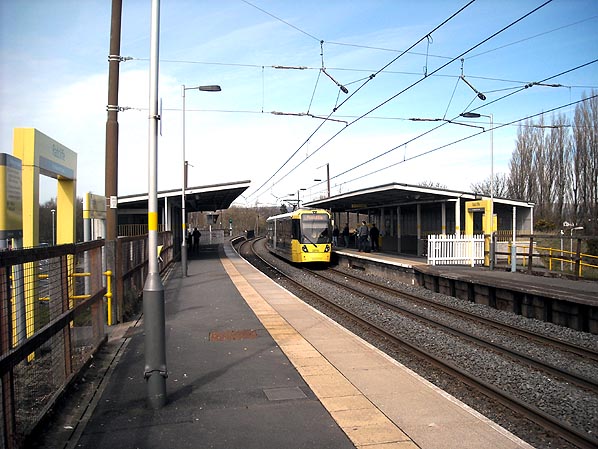
 On 30 July 1879 the section of line between Cheetham Hill Junction and Whitefield was passed by the Board of Trade. Goods services began on 1 August 1879. Passenger services only began after the section between Whitefield and Radcliffe North Junction had received Board of Trade approval on 1 September 1879. From this date passenger services began to run between Manchester Victoria and Bury.
On 30 July 1879 the section of line between Cheetham Hill Junction and Whitefield was passed by the Board of Trade. Goods services began on 1 August 1879. Passenger services only began after the section between Whitefield and Radcliffe North Junction had received Board of Trade approval on 1 September 1879. From this date passenger services began to run between Manchester Victoria and Bury. 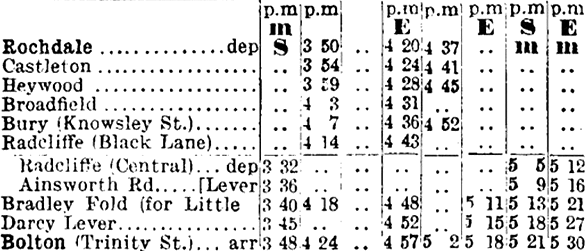

 Home Page
Home Page